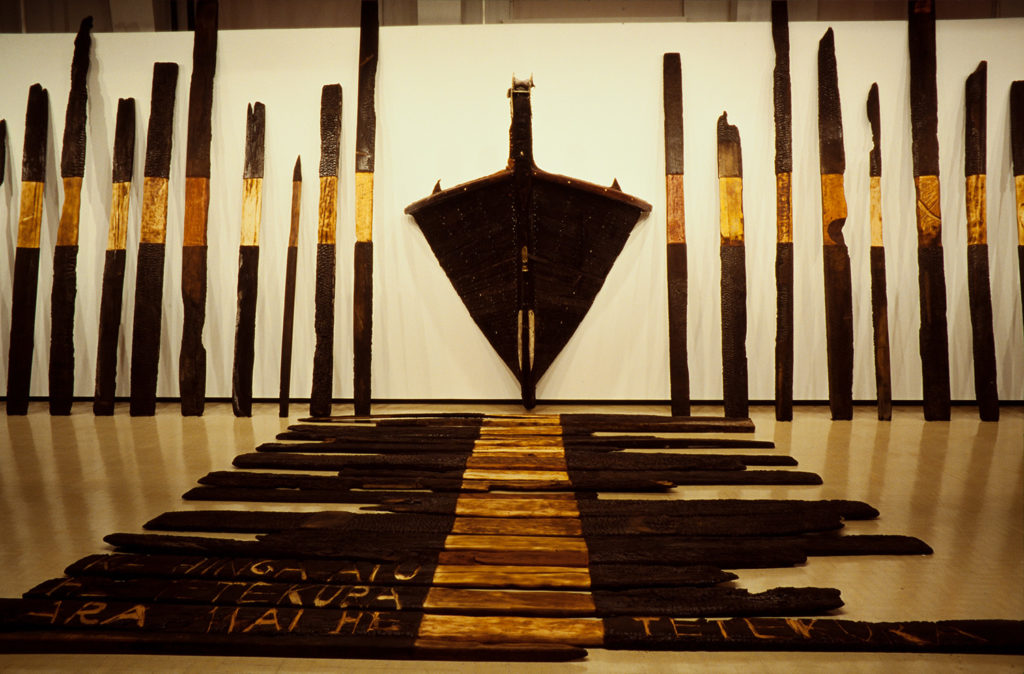In 1984, a fire sweeps through Miller and Tunnage, the boat builders in Carey's Bay, Otago, destroying a twelve-metre fishing boat they were refitting, called the Poitrel. Ralph Hotere (Te Aupōuri) watches the blaze on TV from Hamilton, where he is repairing his Founders Theatre mural. When he returns to Dunedin, he visits the yard and has the wreckage of the Poitrel moved to his studio along with other piles of timber. From these charred remains, Hotere produces Black Phoenix, a major installation.
The Poitrel's blackened bow is mounted on the wall. Burned planks from the hull are lined up vertically like a pa or stockade on either side. Planks are laid horizontally on the floor leading towards the prow as though a jetty. Hotere cleans a section of each plank, stripping it back to reveal the grain, colour, and texture of the timber within. Using a chainsaw, he carves a Māori proverb of survival and regeneration into planks on the floor: 'Ka Hinga atu he tētākura ara mai he tētēkura' (When one frond dies, another takes its place). Hotere says, 'It was bloody hard work ... It was a big job, all sorts of people worked on it.' They include actor Sam Neill, who says it was 'a fun time, helping Ralph with my Black and Decker'.
In Greek mythology, the Phoenix is a golden bird that is reborn from its own ashes. Early Christians adopted it as a symbol of Christ's resurrection. However, the name of Hotere's iwi, Te Aupōuri, can be translated as 'dark smoke', and the story is told of a tīpuna who, when under attack, torched the pā and escaped under cover of the smoke. In Hotere's installation, the Phoenix takes on a political connotation, suggesting the regeneration of Māori society and culture.
Black Phoenix was first shown at Dunedin Public Art Gallery in 1986. It was then exhibited at the National Art Gallery's contemporary-art annex Shed 11 in 1988 as part of the Māori artists show Taki Toru, during which it was acquired by the National Art Gallery. It was already seen as a masterpiece of New Zealand art. In 1992, the National Art Gallery became part of the Museum of New Zealand, and the old Gallery closed, as part of the transition process to the creation of Te Papa.
The City Gallery presentation is therefore significant. Director Paula Savage tells the Sunday Star-Times that she hadn't seen the work before negotiating its loan for the exhibition. 'I had heard a lot about Black Phoenix and it had become a cultural icon ... I wanted to see it but I also thought if I wanted to see it so would other people.' Curator, critic and Cultural Leader (Art) for the Museum of New Zealand, Ian Wedde says, 'It is one of the most elegant, and most eloquent works in the country, for the amount of emotional and other complex information it contains.' He adds, 'It will be one of the central pieces of New Zealand art in future exhibitions in the new gallery, where it will most likely be on almost permanent display.' Savage concludes, 'To be great art, a work must affect the soul, the spirit of a country. It should also tell us something about the mood of a country, and where it is at a particular time. Black Phoenix does that.'
In the Evening Post, reviewer James Mack writes, 'For me it is redolent of palisades and waka and struggle, winning some and losing some, and new beginnings down the slipway of life ... Few artists get to work with the powerful hand of fire, and few artists observe its beauty as it destroys.'

















